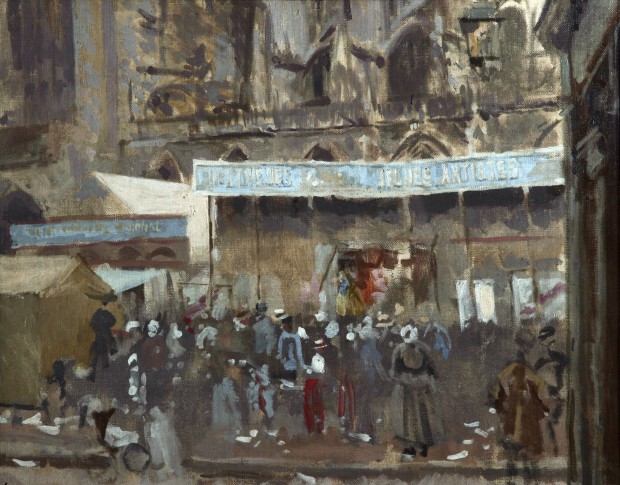Walter Sickert was fluid in both his art and his personality: changeable in style and technique, mutable in appearance — now dressing as a French fisherman, now as a dandy, next shaving his head — and even in name (for a while he styled himself Richard, not Walter, Sickert). All of which makes his long artistic association with the seaside resort of Dieppe apt in more ways than one. This is the theme of an excellent exhibition at Pallant House Gallery, Chichester. A century ago Dieppe was a very Sickertian place.
In ancestry and artistic attitudes, Sickert was an exemplary cosmopolitan. His father was Danish-German; his mother the illegitimate daughter of a wealthy astronomer from Leeds and an Irish dancer (it was from the last, one suspects, that he inherited his handsome looks, and perhaps the impish strain in his character).

Thanks to the London, Brighton and South Coast Railway and the steamboat from Newhaven, the French port was one of the closest bits of abroad to the West End. In the late 19th century, the journey took 11 hours. On one occasion, Sickert’s friends Aubrey Beardsley, Charles Conder and the writer Ernest Dowson set off impromptu on the boat train after an evening’s drinking. When they arrived the next day, these luggage-less decadents would have found a Norman town with ancient churches and picturesque streets, but also grand hotels, nightspots and a casino.
Dieppe was crumbly and up-to-date, seedy and smart all at the same time — a touch of Brighton and a smidgeon of Monte Carlo, with a Norman accent. Over nearly 40 years, from the mid-1880s to the early 1920s, Sickert (1860–1942) painted all these different aspects of the place. The results, as the exhibition demonstrates, were varied in approach, but also uneven in quality.

Sickert at his best was a connoisseur of urban moods that were a bit like the still life he painted of a piece of Roquefort cheese: piquant and pungent. His ‘L’Hôtel Royal’ (1894) — the sky behind a light mauve, the structure itself greenish in the twilight — perfectly catches that desolate, slightly weird quality that seaside places often have.
In that vein, ‘Le Grand Duquesne, Dieppe’ (1902) is an out-and-out masterpiece. It depicts the statue of a local naval hero, Admiral Duquesne, silhouetted in deep shadow against brilliantly sunlit buildings. Around the railings at the base of the monument a few figures are standing aimlessly.
You could not confuse ‘Le Grand Duquesne’ with a work by anyone else (though the enigmatic melancholy is reminiscent of Edward Hopper and also De Chirico). Yet several of the pictures in the same room are nondescript; so, too, are almost all the landscapes done in the country near to Dieppe. ‘Le Vieux Colombier’ (1913) manages to be lurid and dull at the same time.
It is not uncommon for major artists to veer between mediocre and marvellous in this way (Gauguin is another example). In Sickert’s case, the inconsistency was perhaps to do with the complexity of his origins. He was, he once insisted, ‘a French painter’, by which he meant that his two teachers were first Whistler — an expatriate American whose sensibility was formed in France — and later Degas. Sickert produced pictures heavily influenced by both (and featured himself in Degas’s group portrait of ‘Six Friends at Dieppe’ from 1885).

Sickert painted the Church of St Jacques in Dieppe over and over again, which might seem reminiscent of Monet’s depictions of Rouen Cathedral. But Monet analysed the fluctuations of light and air on the façade; Sickert seemed more interested in the dark and brooding aspect of the Gothic structure.There were, however, other ingredients in Sickert’s make-up. He had a pronounced affection for Victorian painting of the ‘every picture tells a story’ variety (and hence an unexpected taste for the works of Frith). This led him to produce eccentric images such as ‘The Blind Sea Captain’ (1914), a tear-jerker in the Pre-Raphaelite mould executed in a technique close to Monet or Pissarro. Also he had a tendency — perhaps derived from his Nordic painter father — towards crepuscular atmospherics.
When all the strains in Sickert’s complex temperament blended together — which was by no means always — the results were compelling. Then, despite his claim — possibly cantankerous — to be a French artist, he can seem the most notable British painter in the century between the death of Turner and the advent of Francis Bacon.






Comments